文章目录
🎪 类和对象
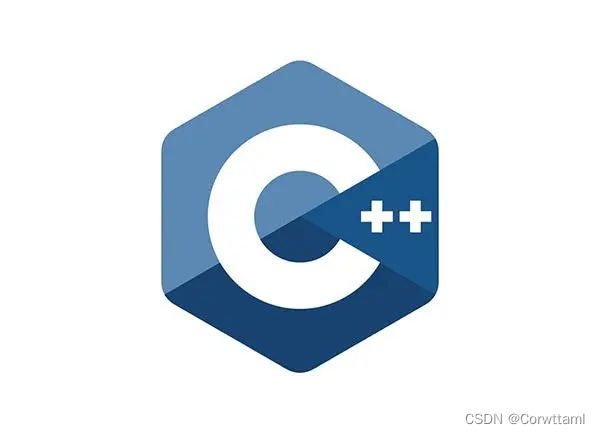
C语言是面向过程的,关注的是过程,分析出求解问题的步骤,通过函数调用逐步解决问题。

洗衣服可以分为以下过程:

C++是基于面向对象的,关注的是对象,将一件事情拆分成不同的对象,靠对象之间的交互完成

总共有四个对象:人,衣服,洗衣粉,洗衣机
而洗衣服的整个规程石油这四个对象交互完成的,使用者不需要关心洗衣机是如何洗衣服的,如何甩干的
🚀1.类和对象基础
C语言结构体中只能定义变量,在C++中,结构体内不仅可以定义变量,也可以定义函数。比如:用C语言方式实现的栈,结构体中只能定义变量;现在以C++方式实现,struct中也可以定义函数
⭐1.1 类的引入
typedef int DataType;
struct Stack
{
void Init(size_t capacity)
{
_array = (DataType*)malloc(sizeof(DataType) * capacity);
if (nullptr == _array)
{
perror("malloc申请空间失败");
return;
}
_capacity = capacity;
_size = 0;
}
void Push(const DataType& data)
{
// 扩容
_array[_size] = data;
++_size;
}
DataType Top()
{
return _array[_size - 1];
}
void Destroy()
{
if (_array)
{
free(_array);
_array = nullptr;
_capacity = 0;
_size = 0;
}
}
DataType* _array;
size_t _capacity;
size_t _size;
};
上面结构体的定义,在C++中更喜欢用class来代替.

⭐1.2 类的定义
类的定义如下:
class className
{
// 类体:由成员函数和成员变量组成
}; // 一定要注意后面的分号
class为定义类的关键字,ClassName为类的名字,{}中为类的主体,注意类定义结束时后面分号不能省略。
类体中内容称为类的成员:类中的变量称为类的属性或成员变量; 类中的函数称为类的方法或者成员函数。
类的两种定义方式:
-
声明和定义全部放在类体中,需注意:成员函数如果在类中定义,编译器可能会将其当成内联函数处理
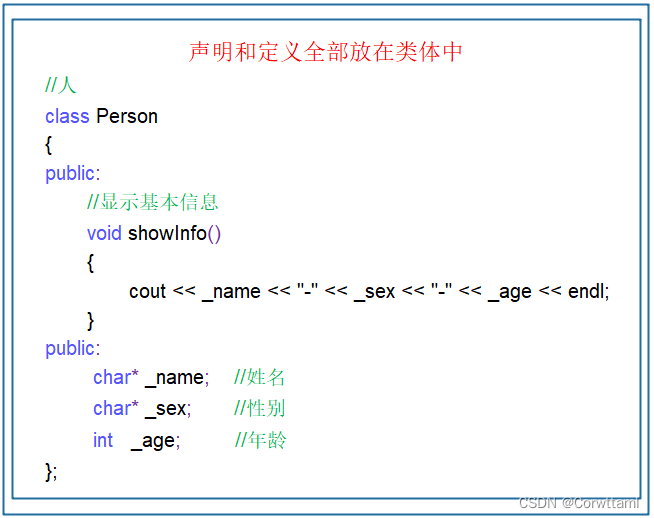
-
类声明放在.h文件中,成员函数定义放在.cpp文件中,注意:成员函数名前需要加类名
::
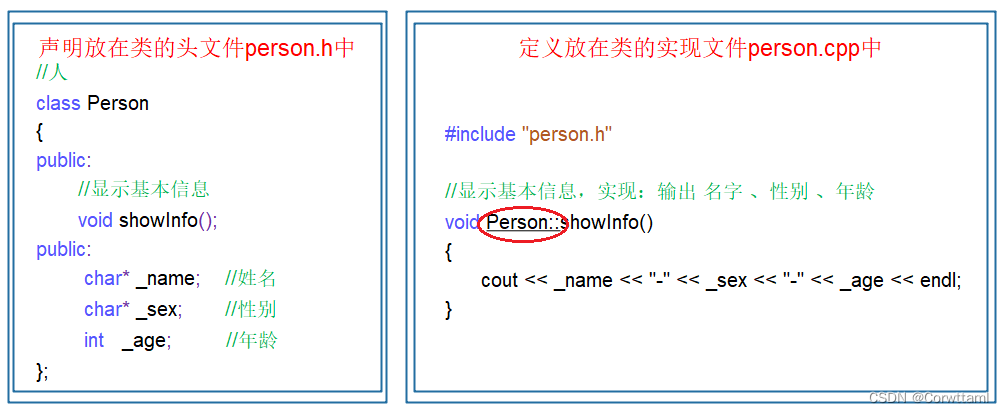
推荐第二种方式更加稳妥一些,但我们日常做题就不用考虑了.
我们对于成员变量一般在变量前加上_,或者后方加入,易于区分
int _year;
int _month;
int _day;
⭐1.3 类的封装
C++对于类的封装主要由访问限定符实现:用类将对象的属性与方法结合在一块,让对象更加完善,通过访问权限选择性的将其接口提供给外部的用户使用
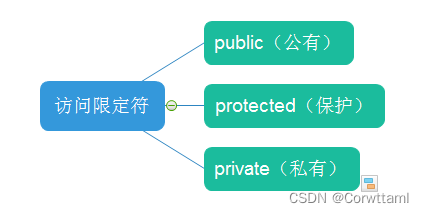
注意:
1. public修饰的成员在类外可以直接被访问
2. protected和private修饰的成员在类外不能直接被访问(此处protected和private是类似的)
3. 访问权限作用域从该访问限定符出现的位置开始直到下一个访问限定符出现时为止
4. 如果后面没有访问限定符,作用域就到 } 即类结束。
5. class的默认访问权限为private,struct为public(因为struct要兼容C)
注意:访问限定符只在编译时有用,当数据映射到内存后,没有任何访问限定符上的区别
面试题:C++中
struct和class的区别是什么?
C++需要兼容C语言,所以C++中struct可以当成结构体使用。另外C++中struct还可以用来定义类。和class定义类是一样的,区别是struct定义的类默认访问权限是public,class定义的类默认访问权限是private。注意:在继承和模板参数列表位置,struct和class也有区别
C++是面向对象的,面向对象的三大特性分别为:封装,继承,多态,那么什么是封装呢?封装:将数据和操作数据的方法进行有机结合,隐藏对象的属性和实现细节,仅对外公开接口来和对象进行交互
封装本质上是一种管理,让用户更方便使用类。比如:对于电脑这样一个复杂的设备,提供给用户的就只有开关机键、通过键盘输入,显示器,USB插孔等,让用户和计算机进行交互,完成日常事务。但实际上电脑真正工作的却是CPU、显卡、内存等一些硬件元件

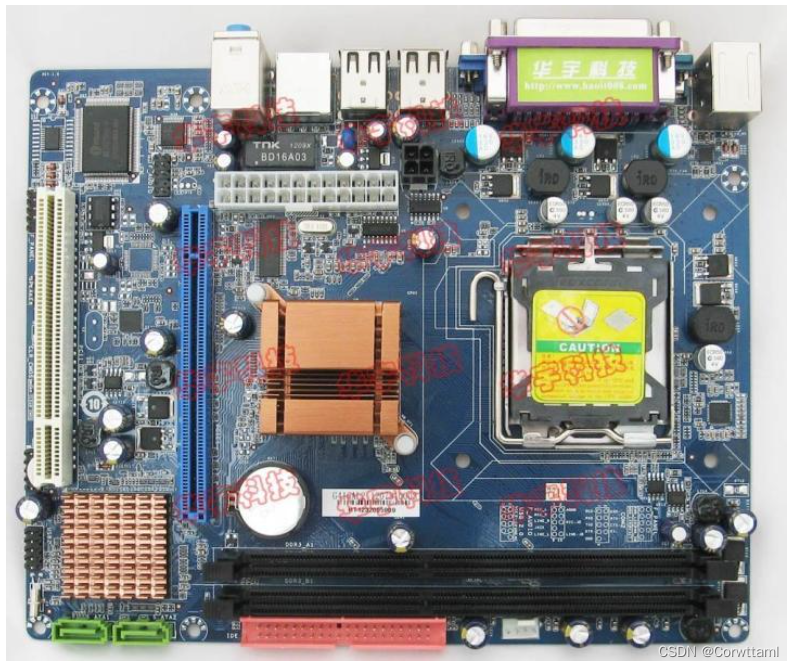
对于计算机使用者而言,不用关心内部核心部件,比如主板上线路是如何布局的,CPU内部是如何设计的等,用户只需要知道,怎么开机、怎么通过键盘和鼠标与计算机进行交互即可。因此计算机厂商在出厂时,在外部套上壳子,将内部实现细节隐藏起来,仅仅对外提供开关机、鼠标以及键盘插孔等,让用户可以与计算机进行交互即可。
在C++语言中实现封装,可以通过类将数据以及操作数据的方法进行有机结合,通过访问权限来隐藏对象内部实现细节,控制哪些方法可以在类外部直接被使用
⭐1.4 类的作用域
类定义了一个新的作用域,类的所有成员都在类的作用域中。在类体外定义成员时,需要使用::作用域操作符指明成员属于哪个类域
class Person
{
public:
void PrintPersonInfo();
private:
char _name[20];
char _gender[3];
int _age;
};
// 这里需要指定PrintPersonInfo是属于Person这个类域
void Person::PrintPersonInfo()
{
cout << _name << " " << _gender << " " << _age << endl;
}
⭐1.5 类对象模型
用类类型创建对象的过程,称为类的实例化.
- 类是对对象进行描述的,是一个模型一样的东西,限定了类有哪些成员,定义出一个类并没有分配实际的内存空间来存储它;比如:入学时填写的学生信息表,表格就可以看成是一个类,来描述具体学生信息。
- 一个类可以实例化出多个对象,实例化出的对象 占用实际的物理空间,存储类成员变量
- 类实例化出对象就像现实中使用建筑设计图建造出房子,类就像是设计图,只设计出需要什么东西,但是并没有实体的建筑存在,同样类也只是一个设计,实例化出的对象才能实际存储数据,占用物理空间
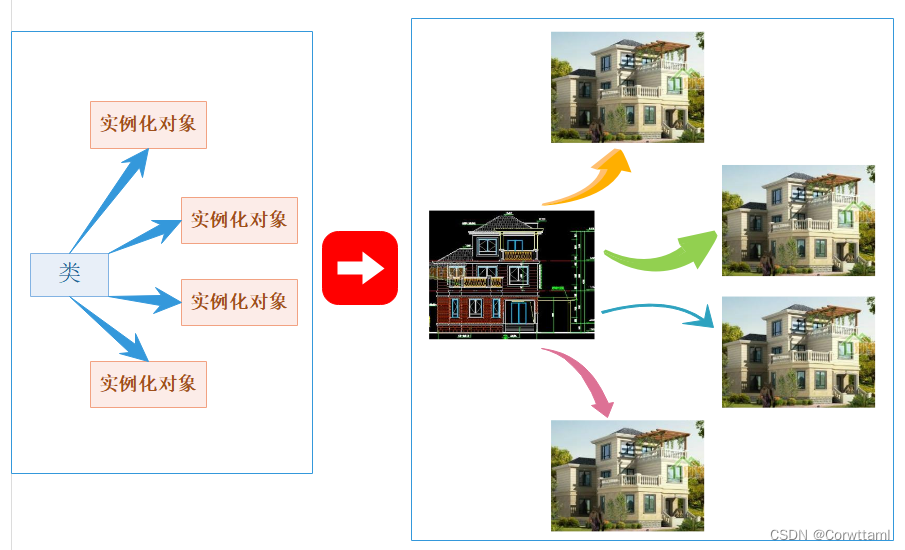
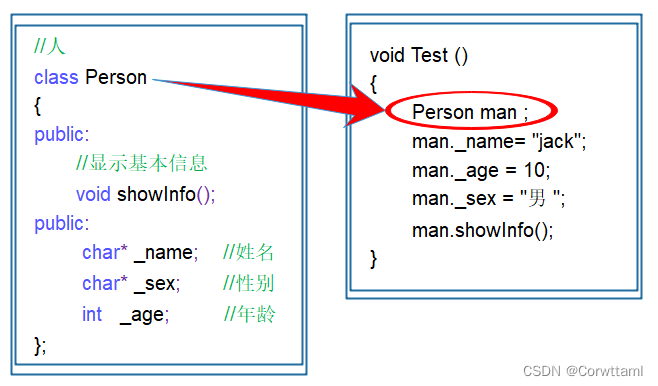
那么类对象的大小怎么计算呢?
类中不仅有成员变量还有成员方法,该怎么计算类的大小呢?我们给出以下三中猜测:
- 对象中包含类的各个成员
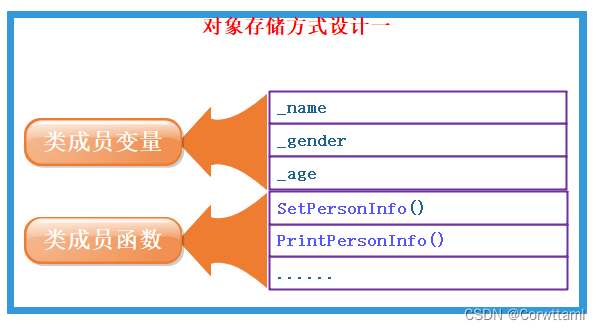
缺陷:每个对象中成员变量是不同的,但是调用同一份函数,如果按照此种方式存储,当一个类创建多个对象时,每个对象中都会保存一份代码,相同代码保存多次,浪费空间。
- 代码只保存一份,在对象中保存存放代码的地址
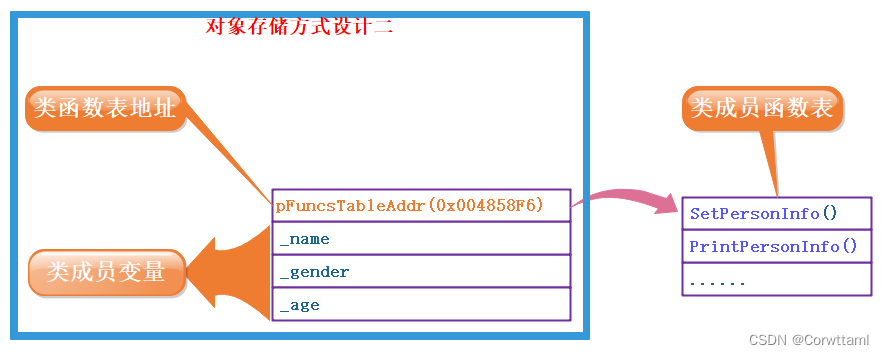
- 只保存成员变量,成员函数存放在公共的代码段
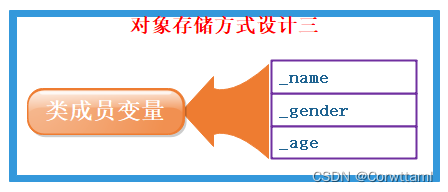
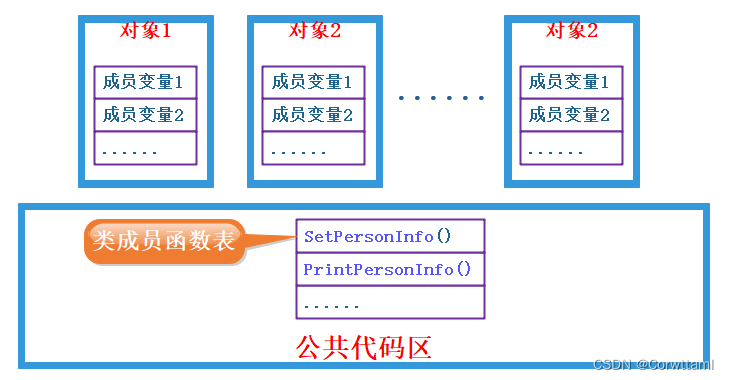
那么计算机是按什么方式来存储的呢?我们可以用sizeof计算不同类的大小:
class A1 {
public:
void f1() {}
private:
int _a;
};
// 类中仅有成员函数
class A2 {
public:
void f2() {}
};
// 类中什么都没有---空类
class A3
{};
int main()
{
cout << sizeof(A1) << endl;//4
cout << sizeof(A2) << endl;//1
cout << sizeof(A3) << endl;//1
return 0;
}
结论:一个类的大小,实际就是该类中”成员变量”之和(计算方法跟结构体相同忽略成员方法,因为成员方法放在公共代码段),当然要注意内存对齐注意空类的大小,空类比较特殊,编译器给了空类一个字节来唯一标识这个类的对象
⭐1.6 面试题
- 结构体怎么对齐? 为什么要进行内存对齐?
为了最大程度地利用内存,减少内存浪费,提高数据访问的效率,需要进行结构体的内存对齐。内存对齐是指将结构体的成员变量按照特定规则对齐,使得结构体中每个成员变量的起始地址都是某个固定值(通常是成员变量大小的整数倍),从而保证了数据的访问效率和存储空间的最优利用。
具体来说,结构体内存对齐需要遵循以下规则:
1.第一个成员在与结构体偏移量为0的地址处。
2. 其他成员变量要对齐到某个数字(对齐数)的整数倍的地址处。注意:对齐数 = 编译器默认的一个对齐数 与 该成员大小的较小值。VS中默认的对齐数为8
3. 结构体总大小为:最大对齐数(所有变量类型最大者与默认对齐参数取最小)的整数倍。
4. 如果嵌套了结构体的情况,嵌套的结构体对齐到自己的最大对齐数的整数倍处,结构体的整体大小就是所有最大对齐数(含嵌套结构体的对齐数)的整数倍
- 如何让结构体按照指定的对齐参数进行对齐?能否按照3、4、5即任意字节对齐?
在C语言中,可以使用特定的指令或属性来控制结构体的对齐方式。以下是常用的控制对齐方式的方式:
1.
#pragma pack(n):在结构体定义之前使用该指令可以指定结构体的对齐方式,n表示指定的对齐参数,通常是2、4、8或者16等整数值。例如, #pragma pack(4) 表示按照4字节对齐。
2.attribute((aligned(n))):在结构体定义中使用该属性也可以指定结构体的对齐方式,n表示指定的对齐参数,与 #pragma pack(n) 的作用类似。
需要注意的是,不同的编译器可能支持不同的指令或属性来控制结构体的对齐方式,因此在使用时需要仔细查阅编译器的文档。
另外,对于第三种方式,也就是任意字节对齐,C语言标准并没有提供直接的支持,但是可以通过一些技巧实现。例如,在结构体中定义一个类型为 char 数组的成员变量,可以将该成员变量的长度设置为所需要的字节数,从而实现任意字节对齐。不过,这种做法可能会增加内存的浪费,降低程序的性能和效率,因此需要谨慎使用。
- 什么是大小端?如何测试某台机器是大端还是小端,有没有遇到过要考虑大小端的场景?
大小端(Endianness)是一种存储数据的方式,指定了多字节数据在内存中的存储顺序。主要有两种不同的存储方式:大端模式(Big Endian)和小端模式(Little Endian)。
在大端模式中,一个多字节数据的高位字节被存储在内存的低地址处,而低位字节被存储在高地址处;在小端模式中,一个多字节数据的低位字节被存储在内存的低地址处,而高位字节被存储在高地址处。例如,十六进制数值0x12345678在大端模式中被存储为0x12 0x34 0x56 0x78,在小端模式中被存储为0x78 0x56 0x34 0x12。
要测试一台机器是大端还是小端,可以编写一个简单的程序,使用指针来检查一个整数在内存中的存储顺序。例如,在C语言中,可以使用以下代码:
#include <stdio.h>
int main() {
unsigned int i = 0x12345678;
char *c = (char*)&i;
if (*c == 0x12) {
printf("This machine is big-endian.\n");
} else if (*c == 0x78) {
printf("This machine is little-endian.\n");
} else {
printf("Unknown endianness.\n");
}
return 0;
}
上述代码将一个无符号整数0x12345678存储到i变量中,并将i的地址强制转换为指向char类型的指针。然后,代码检查指针所指向的字节,以确定机器的大小端模式。
在实际开发中,需要考虑大小端的场景很多。例如,当在不同的平台之间传输二进制数据时,必须考虑大小端问题。如果两个平台的大小端模式不同,那么数据在传输过程中需要进行字节序的转换,否则接收方无法正确解析数据。此外,在某些应用程序中,特别是在网络编程和嵌入式系统开发中,必须考虑大小端问题。
⭐1.7 this指针
我们先简单定义一个日期类Date:
class Date
{
public:
void Init(int year, int month, int day)
{
_year = year;
_month = month;
_day = day;
}
private:
int _year; //声明
int _month;
int _day;
};
int main()
{
Date d1;
Date d2;
d1.Init(2022, 2, 2);
d2.Init(2023, 3, 3);
d1.Print();
d2.Print();
return 0;
}
Date类中有 Init 与 Print 两个成员函数,函数体中没有关于不同对象的区分,那当d1调用 Init 函数时,该函数是如何知道应该设置d1对象,而不是设置d2对象呢?
C++中通过引入this指针解决该问题,即:C++编译器给每个“非静态的成员函数“增加了一个隐藏的指针参数,让该指针指向当前对象(函数运行时调用该函数的对象),在函数体中所有“成员变量”的操作,都是通过该指针去访问。只不过所有的操作对用户是透明的,即用户不需要来传递,编译器自动完成
在编译的时候,Init函数实际上是下面这样子的:
void Init(Date* this, int year, int month, int day)
{
this->_year = year;
this->_month = month;
this->_day = day;
}
this指针还有以下特性:
- this指针的类型:类类型
* const,即成员函数中,不能给this指针赋值。 - 只能在“成员函数”的内部使用
- this指针本质上是“成员函数”的形参,当对象调用成员函数时,将对象地址作为实参传递给this形参。所以对象中不存储this指针。
- this指针是“成员函数”第一个隐含的指针形参,一般情况由编译器通过
ecx寄存器自动传递,不需要用户传递

面试题:
-
this指针存在于哪里?
答:栈上面,因为它是隐含的形参 -
this指针可以为NULL吗?
在某些情况下可以,可以把this指针设置为NULL,不会影响程序的结果,但是某些情况下程序容易出先空指针访问崩溃.
如下是一个程序:
class Date
{
public:
void Init(int year, int month, int day)
{
_year = year;
_month = month;
_day = day;
}
//编译器做的
/*void Init(Date* this, int year, int month, int day)
{
this->_year = year;
this->_month = month;
this->_day = day;
}*/
void func()
{
cout << "6" << endl;
}
private:
int _year; //声明
int _month;
int _day;
};
int main()
{
Date d1;
Date d2;
d1.Init(2022, 2, 2);
d2.Init(2023, 2, 2);
// 编译报错 运行崩溃 正常运行
Date* ptr = nullptr;
//ptr->Init(2022, 2, 2); // 1.运行崩溃
ptr->func(); // 2.正常运行
(*ptr).func(); // 3.正常运行
return 0;
}
第1处的运行崩溃是因为其中的this指针解引用(NULL指针解引用)而发生程序崩溃,2.3处的this并没有解引用(ptr->func()不是解引用访问)
⭐1.8 C/C++实现栈对比
C语言:
typedef struct Stack
{
DataType* array;
int capacity;
int size;
}Stack;
void StackInit(Stack* ps)
{
assert(ps);
ps->array = (DataType*)malloc(sizeof(DataType) * 3);
if (NULL == ps->array)
{
assert(0);
return;
}
ps->capacity = 3;
ps->size = 0;
}
void StackDestroy(Stack* ps)
{
assert(ps);
if (ps->array)
{
free(ps->array);
ps->array = NULL;
ps->capacity = 0;
ps->size = 0;
}
}
void CheckCapacity(Stack* ps)
{
if (ps->size == ps->capacity)
{
int newcapacity = ps->capacity * 2;
DataType* temp = (DataType*)realloc(ps->array,
newcapacity * sizeof(DataType));
if (temp == NULL)
{
perror("realloc申请空间失败!!!");
return;
}
ps->array = temp;
ps->capacity = newcapacity;
}
}
void StackPush(Stack* ps, DataType data)
{
assert(ps);
CheckCapacity(ps);
ps->array[ps->size] = data;
ps->size++;
}
int StackEmpty(Stack* ps)
{
assert(ps);
return 0 == ps->size;
}
void StackPop(Stack* ps)
{
if (StackEmpty(ps))
return;
ps->size--;
}
DataType StackTop(Stack* ps)
{
assert(!StackEmpty(ps));
return ps->array[ps->size - 1];
}
int StackSize(Stack* ps)
{
assert(ps);
return ps->size;
}
int main()
{
Stack s;
StackInit(&s);
StackPush(&s, 1);
StackPush(&s, 2);
StackPush(&s, 3);
StackPush(&s, 4);
printf("%d\n", StackTop(&s));//4
printf("%d\n", StackSize(&s));//4
StackPop(&s);
StackPop(&s);
printf("%d\n", StackTop(&s));//2
printf("%d\n", StackSize(&s));//2
StackDestroy(&s);
return 0;
}
可以看到,在用C语言实现时,Stack相关操作函数有以下共性:
- 每个函数的第一个参数都是Stack*
- 函数中必须要对第一个参数检测,因为该参数可能会为NULL
- 函数中都是通过Stack*参数操作栈的
- 调用时必须传递Stack结构体变量的地址
结构体中只能定义存放数据的结构,操作数据的方法不能放在结构体中,而且实现上相当复杂一点,涉及到大量指针操作,稍不注意可能就会出错。
即数据和方法是分离的,且数据访问控制是自由的不受限制的
C++:
typedef int DataType;
class Stack
{
public:
void Init()
{
_array = (DataType*)malloc(sizeof(DataType) * 3);
if (NULL == _array)
{
perror("malloc申请空间失败!!!");
return;
}
_capacity = 3;
_size = 0;
}
void Push(DataType data)
{
CheckCapacity();
_array[_size] = data;
_size++;
}
void Pop()
{
if (Empty())
return;
_size--;
}
DataType Top() { return _array[_size - 1]; }
int Empty() { return 0 == _size; }
int Size() { return _size; }
void Destroy()
{
if (_array)
{
free(_array);
_array = NULL;
_capacity = 0;
_size = 0;
}
}
private:
void CheckCapacity()
{
if (_size == _capacity)
{
int newcapacity = _capacity * 2;
DataType* temp = (DataType*)realloc(_array, newcapacity *
sizeof(DataType));
if (temp == NULL)
{
perror("realloc申请空间失败!!!");
return;
}
_array = temp;
_capacity = newcapacity;
}
}
private:
DataType* _array;
int _capacity;
int _size;
};
int main()
{
Stack s;
s.Init();
s.Push(1);
s.Push(2);
s.Push(3);
s.Push(4);
printf("%d\n", s.Top());
printf("%d\n", s.Size());
s.Pop();
s.Pop();
printf("%d\n", s.Top());
printf("%d\n", s.Size());
s.Destroy();
return 0;
}
C++中通过类可以将数据 以及 操作数据的方法进行完美结合,通过访问权限可以控制那些方法在类外可以被调用,即封装,在使用时就像使用自己的成员一样,更符合人类对一件事物的认知。而且每个方法不需要传递Stack*的参数了,编译器编译之后该参数会自动还原,即C++中 Stack *参数是编译器维护的,C语言中需用用户自己维护
即数据和方法都封装在类里面,且控制访问方式
🚀2.类的六个默认成员函数
如果一个类中什么成员都没有,简称为空类。空类中真的什么都没有吗?并不是,任何类在什么都不写时,编译器会自动生成以下6个默认成员函数。

默认成员函数:用户没有显式实现,编译器会生成的成员函数称为默认成员函数,这里我们讲前四个,因为后面的大多数情况是不会由程序员实现的.
⭐2.1 构造函数
对于一个日期类:
class Date
{
public:
void Init(int year, int month, int day)
{
_year = year;
_month = month;
_day = day;
}
void Print()
{
cout << _year << "-" << _month << "-" << _day << endl;
}
private:
int _year;
int _month;
int _day;
};
int main()
{
Date d1;
d1.Init(2022, 7, 5);
d1.Print();
Date d2;
d2.Init(2022, 7, 6);
d2.Print();
return 0;
}
对于Date类,可以通过 Init 公有方法给对象设置日期,但如果每次创建对象时都调用该方法设置信息,未免有点麻烦,那能否在对象创建时,就将信息设置进去呢?
构造函数是一个特殊的成员函数,名字与类名相同,创建类类型对象时由编译器自动调用,以保证每个数据成员都有 一个合适的初始值,并且在对象整个生命周期内只调用一次
构造函数是特殊的成员函数,需要注意的是,构造函数虽然名称叫构造,但是构造函数的主要任务并不是开空间创建对象,而是初始化对象。
构造函数有以下几点特征:
- 函数名与类名相同。
- 无返回值。
- 对象实例化时编译器自动调用对应的构造函数。
- 构造函数可以重载
class Date
{
public:
// 1.无参构造函数
Date()
{}
// 2.带参构造函数
Date(int year, int month, int day)
{
_year = year;
_month = month;
_day = day;
}
private:
int _year;
int _month;
int _day;
};
void TestDate()
{
Date d1; // 调用无参构造函数
Date d2(2015, 1, 1); // 调用带参的构造函数
// 注意:如果通过无参构造函数创建对象时,对象后面不用跟括号,否则就成了函数声明
// 以下代码的函数:声明了d3函数,该函数无参,返回一个日期类型的对象
// warning C4930: “Date d3(void)”: 未调用原型函数(是否是有意用变量定义的?)
Date d3();
}
实际上,我们在定义构造函数的时候,尽量提供一个全缺省的构造函数,会方便很多
- 如果类中没有显式定义构造函数,则C++编译器会自动生成一个无参的默认构造函数,一旦用户显式定义编译器将不再生成
class Date
{
public:
/*
// 如果用户显式定义了构造函数,编译器将不再生成
Date(int year, int month, int day)
{
_year = year;
_month = month;
_day = day;
}
*/
void Print()
{
cout << _year << "-" << _month << "-" << _day << endl;
}
private:
int _year;
int _month;
int _day;
};
int main()
{
// 将Date类中构造函数屏蔽后,代码可以通过编译,因为编译器生成了一个无参的默认构造函数
// 将Date类中构造函数放开,代码编译失败,因为一旦显式定义任何构造函数,编译器将不再生成
// 无参构造函数,放开后报错:error C2512: “Date”: 没有合适的默认构造函数可用
Date d1;
return 0;
}
对于编译器自己生成的无参构造函数,比如Date类,编译器自己生成的构造函数会将成员变量初始化为随机值,实际上我们不期望这样,那么编译器自己生成的构造函数,是不是看起来毫无用处呢?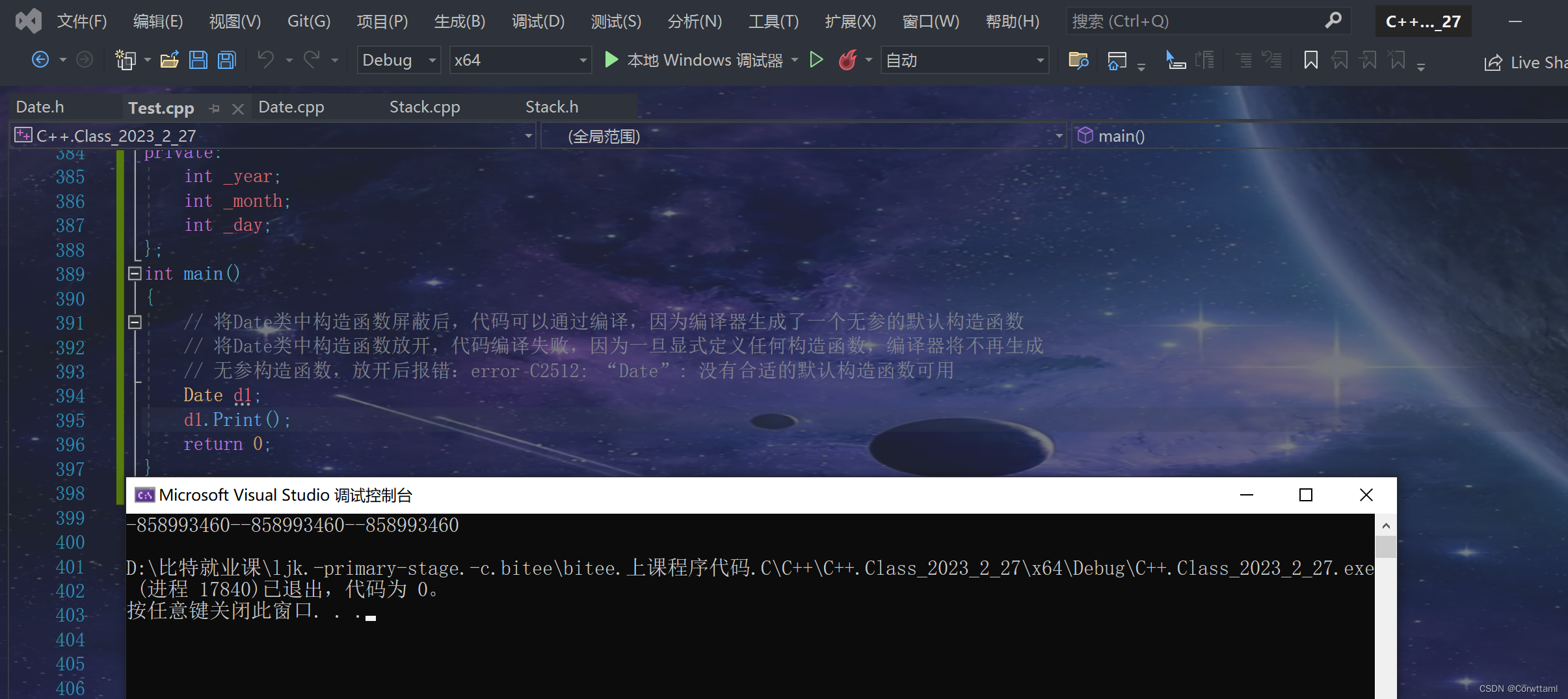
- 实际上,C++把类型分成内置类型(基本类型)和自定义类型。内置类型就是语言提供的数据类型,如:
int/char...,自定义类型就是我们使用class/struct/union等自己定义的类型,看看下面的程序,就会发现编译器生成默认的构造函数会对自定类型成员_t调用的它的默认成员函数
class Time
{
public:
Time()
{
cout << "Time()" << endl;
_hour = 0;
_minute = 0;
_second = 0;
}
private:
int _hour;
int _minute;
int _second;
};
class Date
{
private:
// 基本类型(内置类型)
int _year;
int _month;
int _day;
// 自定义类型
Time _t;
};
int main()
{
Date d;
return 0;
}
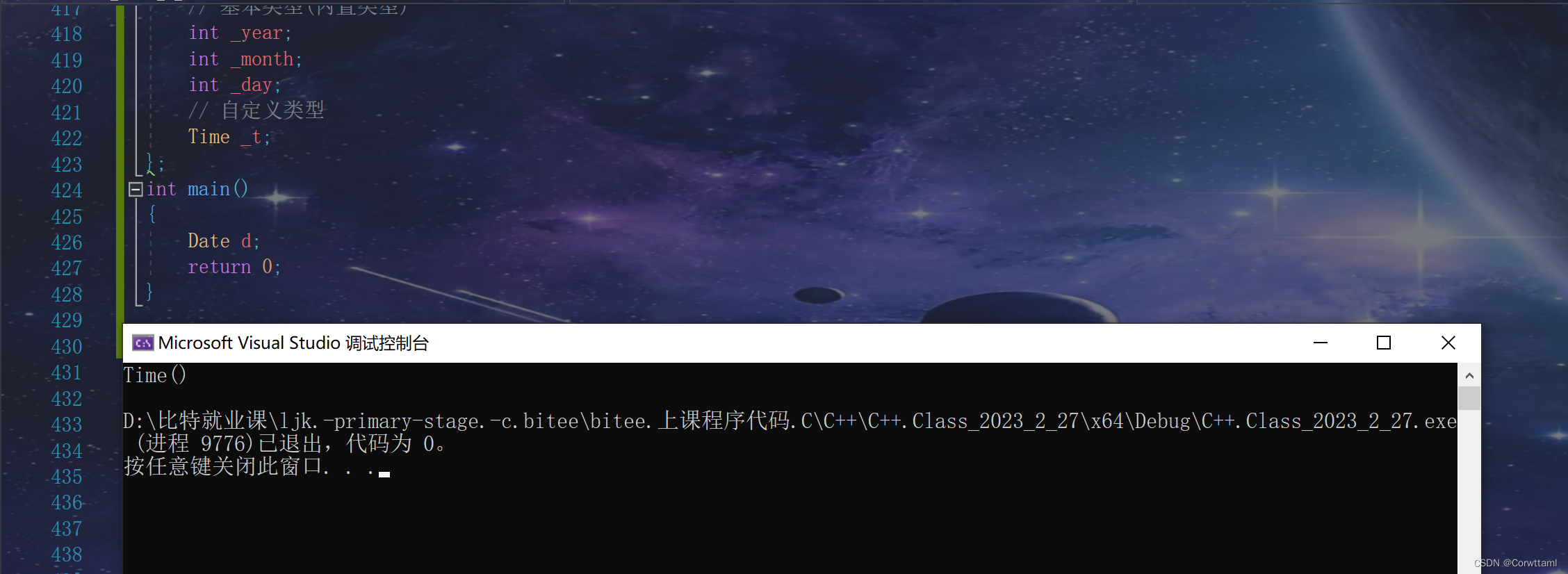
那么对于内置类型,C++98不处理给随机值这种方式实际上是有点不妥当的,然后,C++11 中针对内置类型成员不初始化的缺陷,又打了补丁,即:内置类型成员变量在类中声明时可以给默认值
class Time
{
public:
Time()
{
cout << "Time()" << endl;
_hour = 0;
_minute = 0;
_second = 0;
}
private:
int _hour;
int _minute;
int _second;
};
class Date
{
private:
// 基本类型(内置类型)
int _year = 1970;
int _month = 1;
int _day = 1;
// 自定义类型
Time _t;
};
int main()
{
Date d;
return 0;
}
- 无参的构造函数和全缺省的构造函数都称为默认构造函数,并且默认构造函数只能有一个。注意:无参构造函数、全缺省构造函数、我们没写编译器默认生成的构造函数,都可以认为是默认构造函数
class Date
{
public:
Date()
{
_year = 1900;
_month = 1;
_day = 1;
}
Date(int year = 1900, int month = 1, int day = 1)
{
_year = year;
_month = month;
_day = day;
}
private:
int _year;
int _month;
int _day;
};
// 以下测试函数能通过编译吗?
void Test()
{
Date d1;//不能
}
由于默认构造函数只有一个(全缺省或无参),故此处不能通过编译
⭐2.2 析构函数
对于构造函数,其实是用来代替初始化Init函数的,那么析构函数就是用来代替destroy函数的。
析构函数:与构造函数功能相反,析构函数不是完成对对象本身的销毁,局部对象销毁工作是由编译器完成的。而对象在销毁时会自动调用析构函数,完成对象中资源的清理工作。
析构函数是特殊的成员函数,其特征如下:
- 析构函数名是在类名前加上字符 ~。
- 无参数无返回值类型。
- 一个类只能有一个析构函数。若未显式定义,系统会自动生成默认的析构函数。注意:析构函数不能重载
- 对象生命周期结束时,C++编译系统系统自动调用析构函数
typedef int DataType;
class Stack
{
public:
Stack(size_t capacity = 3)
{
_array = (DataType*)malloc(sizeof(DataType) * capacity);
if (NULL == _array)
{
perror("malloc申请空间失败!!!");
return;
}
_capacity = capacity;
_size = 0;
}
void Push(DataType data)
{
// CheckCapacity();
_array[_size] = data;
_size++;
}
// 其他方法...
~Stack()
{
if (_array)
{
free(_array);
_array = NULL;
_capacity = 0;
_size = 0;
}
}
private:
DataType* _array;
int _capacity;
int _size;
};
void TestStack()
{
Stack s;
s.Push(1);
s.Push(2);
}
- 关于编译器自动生成的析构函数,是否会完成一些事情呢?下面的程序我们会看到,编译器生成的默认析构函数,对自定类型成员调用它的析构函数
class Time
{
public:
~Time()
{
cout << "~Time()" << endl;
}
private:
int _hour;
int _minute;
int _second;
};
class Date
{
private:
// 基本类型(内置类型)
int _year = 1970;
int _month = 1;
int _day = 1;
// 自定义类型
Time _t;
};
int main()
{
Date d;//输出~Time()
return 0;
}
在main方法中根本没有直接创建Time类的对象,为什么最后会调用Time类的析构函数?
因为:main方法中创建了Date对象d,而d中包含4个成员变量,其中_year, _month,_day三个是内置类型成员,销毁时不需要资源清理,最后系统直接将其内存回收即可;而_t是Time类对象,所以在d销毁时,要将其内部包含的Time类的_t对象销毁,所以要调用Time类的析构函数。但是:main函数中不能直接调用Time类的析构函数,实际要释放的是Date类对象,所以编译器会调用Date类的析构函数,而Date没有显式提供,则编译器会给Date类生成一个默认的析构函数,目的是在其内部调用Time类的析构函数,即当Date对象销毁时,要保证其内部每个自定义对象都可以正确销毁main函数中并没有直接调用Time类析构函数,而是显式调用编译器为Date类生成的默认析构函数
注意:创建哪个类的对象则调用该类的析构函数,销毁那个类的对象则调用该类的析构函数
- 如果类中没有申请资源时,析构函数可以不写,直接使用编译器生成的默认析构函数,比如Date类;有资源申请时,一定要写,否则会造成资源泄漏,比如Stack类
⭐2.3 拷贝构造函数
在创建对象时,可以创建一个和已知对象一模一样的对象吗?
拷贝构造函数:只有单个形参,该形参是对本类类型对象的引用(一般常用const修饰),在用已存在的类类型对象创建新对象时由编译器自动调用
拷贝构造函数也是特殊的成员函数,其特征如下:
- 拷贝构造函数是构造函数的一个重载形式。
- 拷贝构造函数的参数只有一个且必须是类类型对象的引用,使用传值方式编译器直接报错,因为会引发无穷递归调用
class Date
{
public:
Date(int year = 1900, int month = 1, int day = 1)
{
_year = year;
_month = month;
_day = day;
}
// Date(Date d) // 错误写法
Date(const Date& d) // 正确写法:编译报错,会引发无穷递归
{
_year = d._year;
_month = d._month;
_day = d._day;
}
private:
int _year;
int _month;
int _day;
};
int main()
{
Date d1;
Date d2(d1);
return 0;
}
因为直接使用直接传值方式进行拷贝构造,实际上传值过程就是拷贝,所以编译器会自动调用拷贝构造函数,也就是再次调用自身,从而形成了死循环.

3. 若未显式定义,编译器会生成默认的拷贝构造函数。 默认的拷贝构造函数对象按内存存储按字节序完成拷贝,这种拷贝叫做浅拷贝,或者值拷贝
class Date
{
public:
Date(int year = 1900, int month = 1, int day = 1)
{
_year = year;
_month = month;
_day = day;
}
// Date(Date d) // 错误写法
Date(const Date& d) // 正确写法:编译报错,会引发无穷递归
{
_year = d._year;
_month = d._month;
_day = d._day;
}
private:
int _year;
int _month;
int _day;
};
int main()
{
Date d1;
Date d2(d1);
return 0;
}
class Time
{
public:
Time()
{
_hour = 1;
_minute = 1;
_second = 1;
}
Time(const Time& t)
{
_hour = t._hour;
_minute = t._minute;
_second = t._second;
cout << "Time::Time(const Time&)" << endl;
}
private:
int _hour;
int _minute;
int _second;
};
class Date
{
private:
// 基本类型(内置类型)
int _year = 1970;
int _month = 1;
int _day = 1;
// 自定义类型
Time _t;
};
int main()
{
Date d1;
// 用已经存在的d1拷贝构造d2,此处会调用Date类的拷贝构造函数
// 但Date类并没有显式定义拷贝构造函数,则编译器会给Date类生成一个默认的拷贝构造函数
Date d2(d1);
return 0;
}
注意:在编译器生成的默认拷贝构造函数中,内置类型是按照字节方式直接拷贝的,而自定义类型是调用其拷贝构造函数完成拷贝的。
- 编译器生成的默认拷贝构造函数可以完成字节序的值拷贝,那么我们是不是可以不写拷贝构造函数了呢?我们再看看下面的类:
// 这里会发现下面的程序会崩溃掉?这里就需要我们以后讲的深拷贝去解决。
typedef int DataType;
class Stack
{
public:
Stack(size_t capacity = 10)
{
_array = (DataType*)malloc(capacity * sizeof(DataType));
if (nullptr == _array)
{
perror("malloc申请空间失败");
return;
}
_size = 0;
_capacity = capacity;
}
void Push(const DataType& data)
{
// CheckCapacity();
_array[_size] = data;
_size++;
}
~Stack()
{
if (_array)
{
free(_array);
_array = nullptr;
_capacity = 0;
_size = 0;
}
}
private:
DataType* _array;
size_t _size;
size_t _capacity;
};
int main()
{
Stack s1;
s1.Push(1);
s1.Push(2);
s1.Push(3);
s1.Push(4);
Stack s2(s1);
return 0;
}
程序为什么会崩溃呢?浅拷贝的只是值拷贝,相当于只是拷贝了指向栈空间的指针,就相当于有两个指针都指向同一块空间,最后析构函数释放空间,s2已经释放了的指针对应的空间,然后s1再去析构,相当于free2次,自然程序会崩溃
注意:类中如果没有涉及资源申请时,拷贝构造函数是否写都可以;一旦涉及到资源申请时,则拷贝构造函数是一定要写的,否则就是浅拷贝
- 拷贝构造函数典型调用场景:使用已存在对象创建新对象,函数参数类型为类类型对象,函数返回值类型为类类型对象
class Date
{
public:
Date(int year, int minute, int day)
{
cout << "Date(int,int,int):" << this << endl;
}
Date(const Date& d)
{
cout << "Date(const Date& d):" << this << endl;
}
~Date()
{
cout << "~Date():" << this << endl;
}
private:
int _year;
int _month;
int _day;
};
Date Test(Date d)
{
Date temp(d);
return temp;
}
int main()
{
Date d1(2022, 1, 13);
Test(d1);
return 0;
}

为了提高程序效率,一般对象传参时,尽量使用引用类型,返回时根据实际场景,能用引用尽量使用引用(除了特殊情况例如函数中返回对象已经销毁)
⭐2.4 赋值运算符重载
C++为了增强代码的可读性引入了运算符重载,运算符重载是具有特殊函数名的函数,也具有其返回值类型,函数名字以及参数列表,其返回值类型与参数列表与普通的函数类似。
函数名字为:关键字operator后面接需要重载的运算符符号。
函数原型:返回值类型 operator操作符(参数列表)
注意:
- 不能通过连接其他符号来创建新的操作符:比如operator@
- 重载操作符必须有一个类类型参数
- 用于内置类型的运算符,其含义不能改变,例如:内置的整型+,不能改变其含义
- 作为类成员函数重载时,其形参看起来比操作数数目少1,因为成员函数的第一个参数为隐藏的this
.*::sizeof?:.注意以上5个运算符不能重载。这个经常在笔试选择题中出现
// 全局的operator==
class Date
{
public:
Date(int year = 1900, int month = 1, int day = 1)
{
_year = year;
_month = month;
_day = day;
}
//private:
int _year;
int _month;
int _day;
};
// 这里会发现运算符重载成全局的就需要成员变量是公有的,那么问题来了,封装性如何保证?
// 这里其实可以用我们后面学习的友元解决,或者干脆重载成成员函数。
bool operator==(const Date& d1, const Date& d2)
{
return d1._year == d2._year
&& d1._month == d2._month
&& d1._day == d2._day;
}
void Test()
{
Date d1(2018, 9, 26);
Date d2(2018, 9, 27);
cout << (d1 == d2) << endl;
}
这里运算符重载是全局的,那么对于私有的类成员变量如何访问呢?有两种解决办法——友元函数和直接变成类成员
class Date
{
public:
Date(int year = 1900, int month = 1, int day = 1)
{
_year = year;
_month = month;
_day = day;
}
// bool operator==(Date* this, const Date& d2)
// 这里需要注意的是,左操作数是this,指向调用函数的对象
bool operator==(const Date & d2)
{
return _year == d2._year
&& _month == d2._month
&& _day == d2._day;
}
private:
int _year;
int _month;
int _day;
};
运算符重载中有一个特殊的运算符——赋值运算符
- 赋值运算符重载格式
- 参数类型:
const T&,传递引用可以提高传参效率- 返回值类型:
T&,返回引用可以提高返回的效率,有返回值目的是为了支持连续赋值- 检测是否自己给自己赋值
- 返回
*this:要复合连续赋值的含义
class Date
{
public:
Date(int year = 1900, int month = 1, int day = 1)
{
_year = year;
_month = month;
_day = day;
}
Date(const Date& d)
{
_year = d._year;
_month = d._month;
_day = d._day;
}
Date& operator=(const Date& d)
{
if (this != &d)
{
_year = d._year;
_month = d._month;
_day = d._day;
}
return *this;
}
private:
int _year;
int _month;
int _day;
};
- 赋值运算符只能重载成类的成员函数不能重载成全局函数
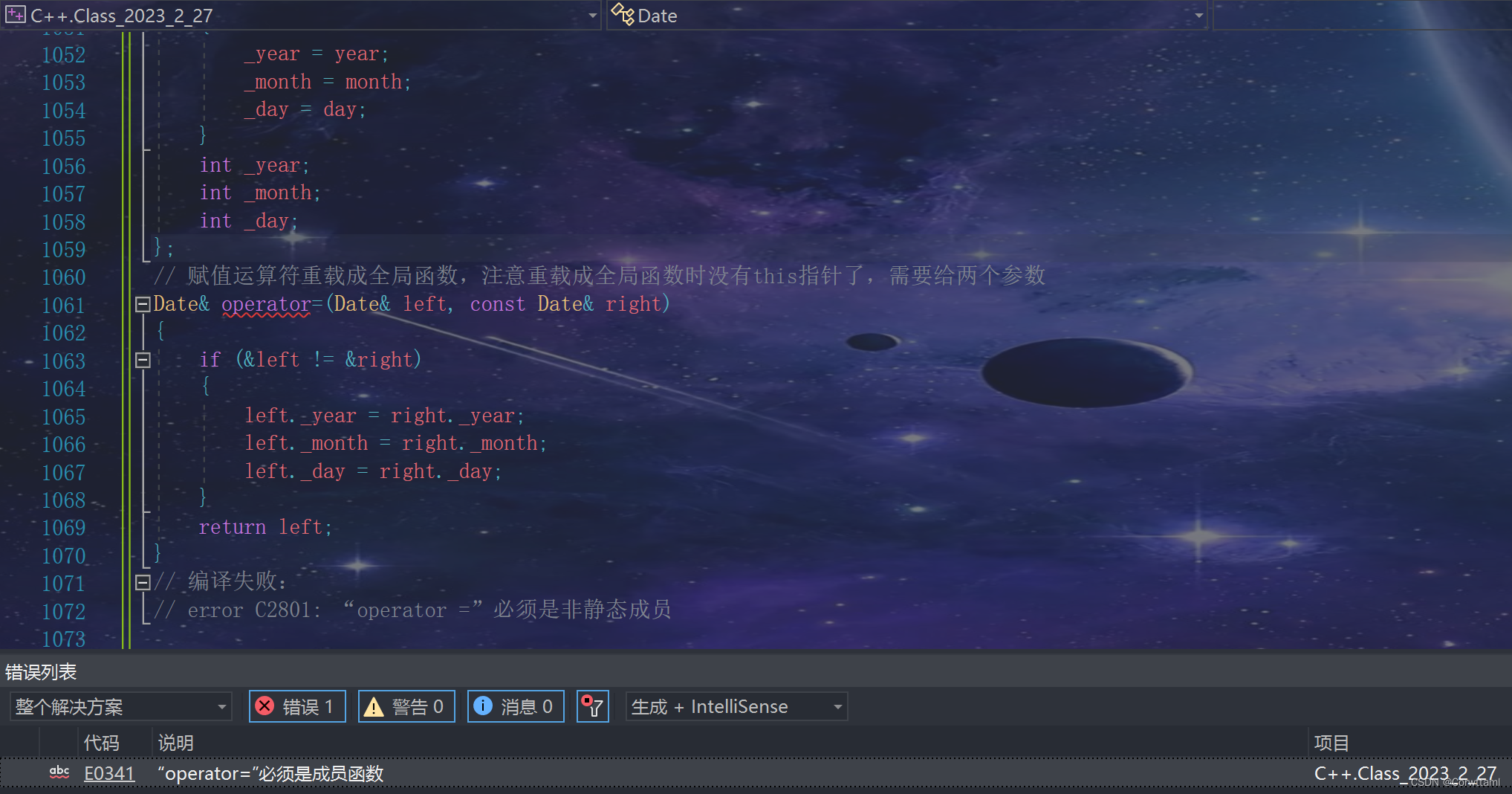
原因:赋值运算符如果不显式实现,编译器会生成一个默认的。此时用户再在类外自己实现一个全局的赋值运算符重载,就和编译器在类中生成的默认赋值运算符重载冲突了,故赋值运算符重载只能是类的成员函数。

- 用户没有显式实现时,编译器会生成一个默认赋值运算符重载,以值的方式逐字节拷贝。注意:内置类型成员变量是直接赋值的,而自定义类型成员变量需要调用对应类的赋值运算符重载完成赋值
class Time
{
public:
Time()
{
_hour = 1;
_minute = 1;
_second = 1;
}
Time& operator=(const Time& t)
{
if (this != &t)
{
_hour = t._hour;
_minute = t._minute;
_second = t._second;
}
return *this;
}
private:
int _hour;
int _minute;
int _second;
};
class Date
{
private:
// 基本类型(内置类型)
int _year = 1970;
int _month = 1;
int _day = 1;
// 自定义类型
Time _t;
};
int main()
{
Date d1;
Date d2;
d1 = d2;
return 0;
}
- 编译器生成的默认赋值运算符重载函数可以完成字节序的值拷贝,但是和拷贝构造一样,凡是涉及资源申请的类,一定要自己实现赋值重载

C++运算符中还有前置++,后置++等运算符,那么怎么实现呢?
class Date
{
public:
Date(int year = 1900, int month = 1, int day = 1)
{
_year = year;
_month = month;
_day = day;
}
// 前置++:返回+1之后的结果
// 注意:this指向的对象函数结束后不会销毁,故以引用方式返回提高效率
Date& operator++()
{
_day += 1;
return *this;
}
// 后置++:
// 前置++和后置++都是一元运算符,为了让前置++与后置++形成能正确重载
// C++规定:后置++重载时多增加一个int类型的参数,但调用函数时该参数不用传递,编译器自动传递
// 注意:后置++是先使用后+1,因此需要返回+1之前的旧值,故需在实现时需要先将this保存一份,然后给this + 1
// 而temp是临时对象,因此只能以值的方式返回,不能返回引用
Date operator++(int)
{
Date temp(*this);
_day += 1;
return temp;
}
private:
int _year;
int _month;
int _day;
};
int main()
{
Date d;
Date d1(2022, 1, 13);
d = d1++; // d: 2022,1,13 d1:2022,1,14
d = ++d1; // d: 2022,1,15 d1:2022,1,15
return 0;
}
⭐2.5 const成员
将const修饰的“成员函数”称之为const成员函数,const修饰类成员函数,实际修饰该成员函数隐含的this指针,表明在该成员函数中不能对类的任何成员进行修改
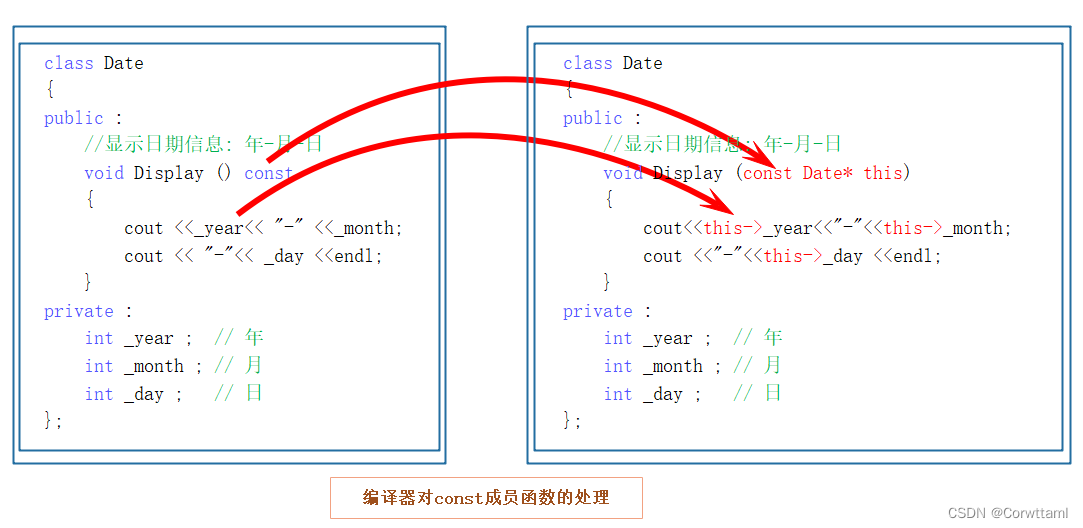
注意:
- const 对象不能调用非 const 成员函数。因为 const 对象的成员是只读的,如果调用非 const 成员函数可能会导致数据修改,违反了 const 对象的只读属性。
- 非 const 对象可以调用 const 成员函数。因为 const 成员函数不会修改对象的状态,所以非 const 对象调用 const 成员函数不会违反对象的属性。
- const 成员函数内可以调用其他非 const 成员函数,但是这些非 const 成员函数不能修改对象的状态。 因为 const 成员函数保证不修改对象的状态,调用其他非 const 成员函数时也必须遵循这个约束。
- 非 const 成员函数内可以调用其他 const 成员函数,因为 const 成员函数不会修改对象的状态,所以在非 const 成员函数内调用 const 成员函数不会违反对象的状态。
所以我们在设计类的时候,如果不涉及修改对象,那么最好加上const,如果涉及修改对象,同时又想让const对象访问,那么最好搞一个重载的const函数
class Date
{
public:
Date(int year, int month, int day)
{
_year = year;
_month = month;
_day = day;
}
void Print()
{
cout << "Print()" << endl;
cout << "year:" << _year << endl;
cout << "month:" << _month << endl;
cout << "day:" << _day << endl << endl;
}
void Print() const
{
cout << "Print()const" << endl;
cout << "year:" << _year << endl;
cout << "month:" << _month << endl;
cout << "day:" << _day << endl << endl;
}
private:
int _year; // 年
int _month; // 月
int _day; // 日
};
void Test()
{
Date d1(2022, 1, 13);
d1.Print();
const Date d2(2022, 1, 13);
d2.Print();
}
⭐2.6 取地址操作符重载(简)
这两个默认成员函数一般不用重新定义 ,编译器默认会生成.
class Date
{
public:
Date* operator&()
{
return this;
}
const Date* operator&()const
{
return this;
}
private:
int _year; // 年
int _month; // 月
int _day; // 日
};
这两个运算符一般不需要重载,使用编译器生成的默认取地址的重载即可,只有特殊情况,才需要重载,比如想让别人获取到指定的内容
⭐2.7 输入输出重载
C++的输入输出一般使用输入输出流,对于其内置类型它可以随意输出,但是对于自定义类型(如Date类),直接用流输出的话会报错,这时就需要我们使用输入输出重载来解决自定义类型的输出
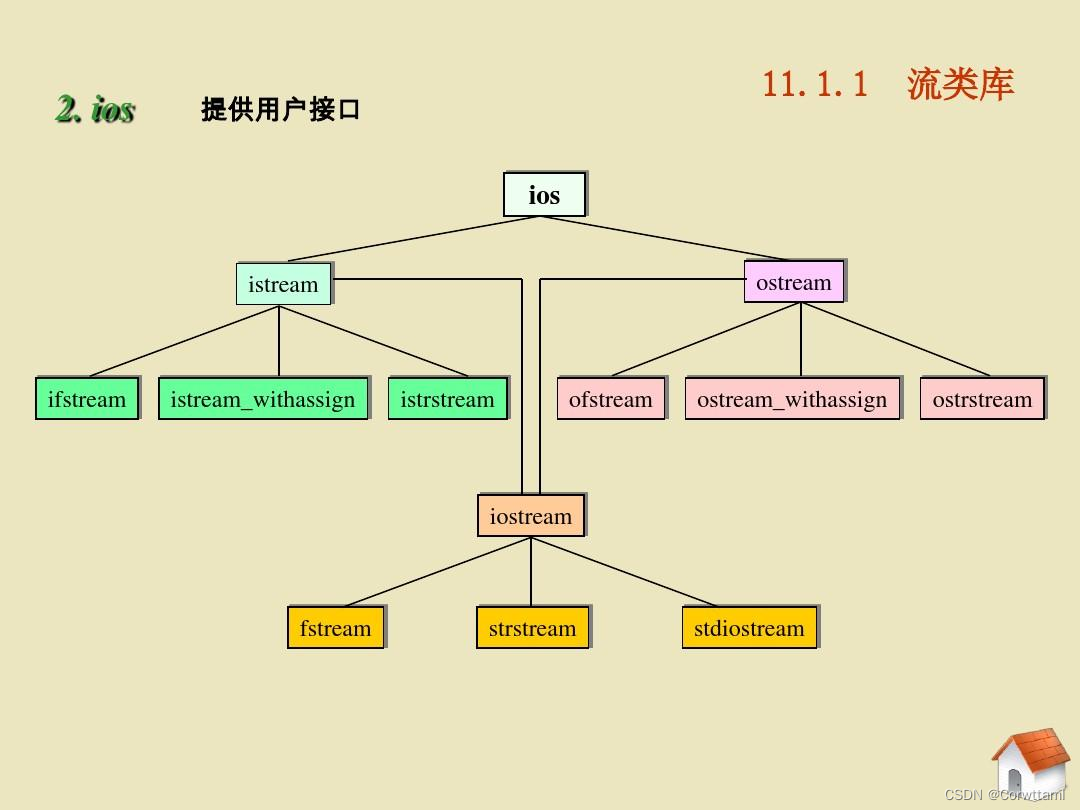
为什么输入输出流可以随意输出内置类型呢?
实际上,这其实也是一种运算符重载,对于不同的参数类型,对流插入符进行重载,实现了对内置类型的输出:
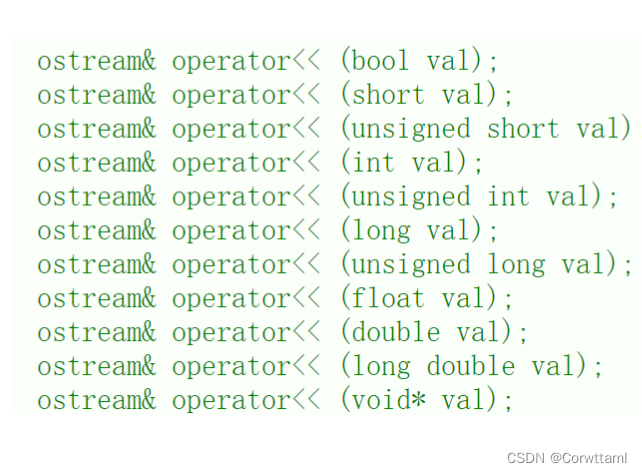
那么我们把自定义类型加进去就可以实现对自定义类型的输出:
但是我们输入输出自定义类型需要面临一个问题,由于类里面的方法,默认第一个参数就是*this,运算符重载默认按照顺序进行重载,左操作数为第一个参数,右操作数为第二个参数,而我们进行流插入或者流提取的时候,左操作数默认是流参数,这就出现了矛盾?
解决办法是将自定义类型的输入输出流重载放在类外面,作为全局变量,将流参数作为第一个参数(也就是左操作数),但是新的问题又出现了,如何访问类中被private修饰的对象,友元函数可以完美的解决该问题,代码如下:
class Date
{
//友元函数
friend inline ostream& operator<<(ostream& out, const Date& d);
friend inline istream& operator>>(istream& in, Date& d);
public:
Date(int year = 1900, int month = 1, int day = 1)
{
_year = year;
_month = month;
_day = day;
}
Date(const Date& d)
{
_year = d._year;
_month = d._month;
_day = d._day;
}
private:
int _year;
int _month;
int _day;
};
//由于流操作符支持连续输入和输出,所以需要返回流对象
inline ostream& operator<<(ostream& out, const Date& d)
{
out << d._year << "年" << d._month << "月" << d._day << "日" << endl;
return out;
}
inline istream& operator>>(istream& in, Date& d)
{
in >> d._year >> d._month >> d._day;
return in;
}
友元函数可以访问类中私有成员变量.
⭐2.8 日期类实现
以下是一个日期类实现:
//Date.h
#pragma once
#include <iostream>
#include <assert.h>
using namespace std;
//日期类声明
class Date
{
friend inline ostream& operator<<(ostream& out, const Date& d);
friend inline istream& operator>>(istream& in, Date& d);
public:
Date(int year = 1900, int month = 1, int day = 1);
void Print() const;
int GetMonthDay(int year, int month) const;
Date GetAfterXDay(int x) const;
bool operator==(const Date& d) const;
bool operator!=(const Date& d) const;
bool operator<(const Date& d) const;
bool operator<=(const Date& d) const;
bool operator>(const Date& d) const;
bool operator>=(const Date& d) const;
Date& operator+=(int day);
Date operator+(int day) const;
Date& operator-=(int day);
Date operator-(int day) const;
int operator-(const Date& d) const;
Date& operator++();
// int参数 仅仅是为了占位,跟前置重载区分
Date operator++(int);
Date& operator--();
Date operator--(int);
private:
int _year;
int _month;
int _day;
};
inline ostream& operator<<(ostream& out, const Date& d)
{
out << d._year << "年" << d._month << "月" << d._day << "日" << endl;
return out;
}
inline istream& operator>>(istream& in, Date& d)
{
in >> d._year >> d._month >> d._day;
return in;
}
//Date.cpp
#define _CRT_SECURE_NO_WARNINGS
#include "Date.h"
//日期类定义
Date::Date(int year, int month, int day)
{
if (month > 0 && month < 13 && day > 0 && day <= GetMonthDay(year, month))
{
_year = year;
_month = month;
_day = day;
}
else
{
cout << "日期不合法" << endl;
}
}
int Date::GetMonthDay(int year, int month) const
{
assert(month > 0 && month < 13);
int monthArray[13] = { 0, 31, 28, 31, 30, 31, 30, 31, 31, 30, 31, 30, 31 };
if (year % 4 == 0 && year % 100 != 0 || year % 400 == 0)
{
monthArray[2] = 29;
}
return monthArray[month];
}
Date Date::GetAfterXDay(int x) const
{
Date ret(*this);
ret._day += x;
while (ret._day > GetMonthDay(ret._year, ret._month))
{
ret._day -= GetMonthDay(ret._year, ret._month);
ret._month++;
if (ret._month == 13)
{
ret._month = 1;
ret._year++;
}
}
return ret;
}
void Date::Print() const
{
cout << _year << "/" << _month << "/" << _day << endl;
}
bool Date::operator==(const Date& d) const
{
return _year == d._year
&& _month == d._month
&& _day == d._day;
}
bool Date::operator!=(const Date& d) const
{
return !(*this == d);
}
bool Date::operator<(const Date& d) const
{
return (_year * 373 + (_month - 1) * 31 + _day) < (d._year * 373 + (d._month - 1) * 31 + _day);
}
bool Date::operator<=(const Date& d) const
{
return (*this < d) || (*this == d);
}
bool Date::operator>(const Date& d) const
{
return !(*this <= d);
}
bool Date::operator>=(const Date& d) const
{
return !(*this < d);
}
Date& Date::operator+=(int day)
{
_day += day;
while (_day > GetMonthDay(_year, _month))
{
_day -= GetMonthDay(_year, _month);
_month++;
if (_month == 13)
{
_year++;
_month = 1;
}
}
return *this;
}
Date Date::operator+(int day) const
{
Date ret(*this);
ret += day;
return ret;
}
Date& Date::operator-=(int day)
{
_day -= day;
while (_day <= 0)
{
_day += GetMonthDay(_year, _month);
_month--;
if (_month == 0)
{
_year--;
_month = 12;
}
}
return *this;
}
Date Date::operator-(int day) const
{
Date ret(*this);
ret -= day;
return ret;
}
int Date::operator-(const Date& d) const
{
Date min = d;
Date max = *this;
int flag = 1;
if (*this < d)
{
max = d;
min = *this;
flag = -1;
}
int n = 0;
while (min != max)
{
min++;
n++;
}
return n * flag;
}
Date& Date::operator++()
{
*this += 1;
return *this;
}
Date Date::operator++(int)
{
Date ret(*this);
*this += 1;
return ret;
}
Date& Date::operator--()
{
*this -= 1;
return *this;
}
Date Date::operator--(int)
{
Date ret(*this);
*this -= 1;
return ret;
}
🚀3.类的特殊成员及用法
⭐3.1 初始化列表
在创建对象时,编译器通过调用构造函数,给对象中各个成员变量一个合适的初始值.
class Date
{
public:
Date(int year, int month, int day)
{
_year = year;
_month = month;
_day = day;
}
private:
int _year;
int _month;
int _day;
};
虽然上述构造函数调用之后,对象中已经有了一个初始值,但是不能将其称为对对象中成员变量的初始化,构造函数体中的语句只能将其称为赋初值,而不能称作初始化。因为初始化只能初始一次,而构造函数体内可以多次赋值。C++提供了初始化列表这种特性,不论哪个对象调用构造函数,初始化列表是所有成员变量定义的位置,不管是否显式在初始化列表写,那么编译器每个变量都会在初始化列表定义初始化.
初始化列表
初始化列表:以一个冒号开始,接着是一个以逗号分隔的数据成员列表,每个"成员变量"后面跟一个放在括号中的初始值或表达式
class Date
{
public:
Date(int year, int month, int day)
: _year(year)
, _month(month)
, _day(day)
{}
private:
int _year;
int _month;
int _day;
};
注意:
1. 每个成员变量在初始化列表中只能出现一次(初始化只能初始化一次)
2. 类中包含以下成员,必须放在初始化列表位置进行初始化:
- 引用成员变量
- const成员变量
- 自定义类型成员(且该类没有默认构造函数时)
class A
{
public:
A(int a)
:_a(a)
{}
private:
int _a;
};
class B
{
public:
B(int a, int ref)
:_aobj(a)
, _ref(ref)
, _n(10)
{}
private:
A _aobj; // 没有默认构造函数
int& _ref; // 引用
const int _n; // const
};
3. 尽量使用初始化列表初始化,因为不管你是否使用初始化列表,对于自定义类型成员变量,一定会先使用初始化列表初始化
class Time
{
public:
Time(int hour = 0)
:_hour(hour)
{
cout << "Time()" << endl;
}
private:
int _hour;
};
class Date
{
public:
Date(int day)
{}
private:
int _day;
Time _t;
};
int main()
{
Date d(1);
}
4. 成员变量在类中声明次序就是其在初始化列表中的初始化顺序,与其在初始化列表中的先后次序无关
class A
{
public:
A(int a)
:_a1(a)
, _a2(_a1)
{}
void Print() {
cout << _a1 << " " << _a2 << endl;
}
private:
int _a2;
int _a1;
};
int main() {
A aa(1);
aa.Print();
}
该程序输出的是(1 随机值),因为根据顺序进行初始化,所以_a2先初始化为随机值
explicit关键字
构造函数不仅可以构造与初始化对象,对于单个参数或者除第一个参数无默认值其余均有默认值的构造函数,还具有类型转换的作用
class A
{
public:
//explicit不允许通过隐式类型转换构造对象(多个或单个都通用)
explicit A(int a)
:_a1(a)
{
cout << "A(int a)" << endl;
}
A(int a1, int a2)
:_a1(a1)
,_a2(a2)
{}
//构造都可以有初始化列表
A(const A& aa)
:_a1(aa._a1)
{
cout << "A(const A& aa)" << endl;
}
private:
int _a1;
int _a2;
};
//
int main()
{
//A aa1(1); //直接调用的构造函数
//C++98就支持,用1构造一个临时对象,然后再用这个对象拷贝构造aa2
//A aa2 = 1; //单参数隐式类型转换 构造 + 拷贝 + 优化 -> 构造(直接拿1来构造aa2)
//依然是隐式类型转换
//const A& ref = 10;
//多参数的构造函数
A aa2(1, 1);
//C++11才支持多参数隐式转换
A aa3 = { 2, 2 };
const A& ref = { 2, 2 };
return 0;
}
⭐3.2 static成员
声明为static的类成员称为类的静态成员,用static修饰的成员变量,称之为静态成员变量;用static修饰的成员函数,称之为静态成员函数。静态成员变量一定要在类外进行初始化(除了static const int成员外,都必须在类外初始化)
面试题:实现一个类,计算程序中创建出了多少个类对象
class A
{
public:
A() { ++_scount; }
A(const A& t) { ++_scount; }
~A() { --_scount; }
static int GetACount() { return _scount; }
private:
//静态成员函数中无法访问非静态成员,没有this指针
static int _scount;
};
//static成员不属于某个对象,属于所有对象,属于整个类
int A::_scount = 0;
void TestA()
{
cout << A::GetACount() << endl;
A a1, a2;
A a3(a1);
cout << A::GetACount() << endl;
}
static成员特性
1. 静态成员为所有类对象所共享,不属于某个具体的对象,存放在静态区
2. 静态成员变量必须在类外定义,定义时不添加static关键字,类中只是声明
3. 类静态成员即可用 类名::静态成员 或者 对象.静态成员 来访问
4. 静态成员函数没有隐藏的this指针,不能访问任何非静态成员
5. 静态成员也是类的成员,受public、protected、private 访问限定符的限制
6.静态成员函数不可以调用非静态成员函数,非静态成员函数可以调用类的静态成员函数
⭐3.3 友元
友元提供了一种突破封装的方式,有时提供了便利。但是友元会增加耦合度,破坏了封装,所以友元不宜多用。
友元分为:友元函数和友元类
我们之前尝试去重载operator<<,然后发现没办法将operator<<重载成成员函数。因为cout的输出流对象和隐含的this指针在抢占第一个参数的位置。this指针默认是第一个参数也就是左操作数了。但是实际使用中cout需要是第一个形参对象,才能正常使用。所以要将operator<<重载成全局函数。但又会导致类外没办法访问成员,此时就需要友元来解决。operator>>同理。重载六运算符必须用友元函数吗?答案是否定,具体需要看类内部的实现.
class Date
{
public:
Date(int year, int month, int day)
: _year(year)
, _month(month)
, _day(day)
{}
// d1 << cout; -> d1.operator<<(&d1, cout); 不符合常规调用
//因为成员函数第一个参数一定是隐藏的this,所以d1必须放在<<的左侧
ostream& operator<<(ostream& _cout)
{
_cout << _year << "-" << _month << "-" << _day << endl;
return _cout;
}
private:
int _year;
int _month;
int _day;
};
友元函数可以直接访问类的私有成员,它是定义在类外部的普通函数,不属于任何类,但需要在类的内部声明,声明时需要加friend关键字。
class Date
{
friend ostream& operator<<(ostream& _cout, const Date& d);
friend istream& operator>>(istream& _cin, Date& d);
public:
Date(int year = 1900, int month = 1, int day = 1)
: _year(year)
, _month(month)
, _day(day)
{}
private:
int _year;
int _month;
int _day;
};
ostream& operator<<(ostream& _cout, const Date& d)
{
_cout << d._year << "-" << d._month << "-" << d._day;
return _cout;
}
istream& operator>>(istream& _cin, Date& d)
{
_cin >> d._year;
_cin >> d._month;
_cin >> d._day;
return _cin;
}
int main()
{
Date d;
cin >> d;
cout << d << endl;
return 0;
}
注意:
- 友元函数可访问类的私有和保护成员,但不是类的成员函数
- 友元函数不能用const修饰
- 友元函数可以在类定义的任何地方声明,不受类访问限定符限制
- 一个函数可以是多个类的友元函数
- 友元函数的调用与普通函数的调用原理相同
友元类
友元类的所有成员函数都可以是另一个类的友元函数,都可以访问另一个类中的非公有成员。
- 友元关系是单向的,不具有交换性。
比如上述Time类和Date类,在Time类中声明Date类为其友元类,那么可以在Date类中直接访问Time类的私有成员变量,但想在Time类中访问Date类中私有的成员变量则不行。 - 友元关系不能传递
如果C是B的友元, B是A的友元,则不能说明C时A的友元。 - 友元关系不能继承
class Time
{
friend class Date; // 声明日期类为时间类的友元类,则在日期类中就直接访问Time类中的私有成员变量
public:
Time(int hour = 0, int minute = 0, int second = 0)
: _hour(hour)
, _minute(minute)
, _second(second)
{}
private:
int _hour;
int _minute;
int _second;
};
class Date
{
public:
Date(int year = 1900, int month = 1, int day = 1)
: _year(year)
, _month(month)
, _day(day)
{}
void SetTimeOfDate(int hour, int minute, int second)
{
// 直接访问时间类私有的成员变量
_t._hour = hour;
_t._minute = minute;
_t._second = second;
}
private:
int _year;
int _month;
int _day;
Time _t;
};
⭐3.4 内部类和匿名对象
概念:如果一个类定义在另一个类的内部,这个内部类就叫做内部类。内部类是一个独立的类,它不属于外部类,更不能通过外部类的对象去访问内部类的成员。外部类对内部类没有任何优越的访问权限。
注意:内部类就是外部类的友元类,参见友元类的定义,内部类可以通过外部类的对象参数来访问外部类中的所有成员。但是外部类不是内部类的友元
特性:
- 内部类可以定义在外部类的public、protected、private都是可以的。
- 注意内部类可以直接访问外部类中的
static成员,不需要外部类的对象/类名。 - sizeof(外部类)=外部类,和内部类没有任何关系
class A
{
private:
static int k;
int h;
public:
class B // B天生就是A的友元
{
public:
void foo(const A& a)
{
cout << k << endl;//OK
cout << a.h << endl;//OK
}
};
};
int A::k = 1;
int main()
{
A::B b;
b.foo(A());
return 0;
}
匿名对象:
class A
{
public:
A(int a = 0)
:_a(a)
{
cout << "A(int a)" << endl;
}
~A()
{
cout << "~A()" << endl;
}
private:
int _a;
};
class Solution {
public:
int Sum_Solution(int n) {
//...
return n;
}
};
int main()
{
// 我们可以这么定义匿名对象,匿名对象的特点不用取名字,
// 但是他的生命周期只有这一行,我们调试可以看到下一行他就会自动调用析构函数
A();
A aa2(2);
// 匿名对象在这样场景下使用
Solution().Sum_Solution(10);
return 0;
}
⭐3.5 拷贝对象时的一些编译器优化
在传参和传返回值的过程中,一般编译器会做一些优化,减少对象的拷贝,这个在一些场景下还是非常有用的。
class A
{
public:
A(int a = 0)
:_a(a)
{
cout << "A(int a)" << endl;
}
A(const A& aa)
:_a(aa._a)
{
cout << "A(const A& aa)" << endl;
}
A& operator=(const A& aa)
{
cout << "A& operator=(const A& aa)" << endl;
if (this != &aa)
{
_a = aa._a;
}
return *this;
}
~A()
{
cout << "~A()" << endl;
}
private:
int _a;
};
void f1(A aa)
{}
A f2()
{
A aa;
return aa;
}
int main()
{
// 传值传参
A aa1;
f1(aa1);
cout << endl;
// 传值返回
f2();
cout << endl;
// 隐式类型,连续构造+拷贝构造->优化为直接构造
f1(1);
// 一个表达式中,连续构造+拷贝构造->优化为一个构造
f1(A(2));
cout << endl;
// 一个表达式中,连续拷贝构造+拷贝构造->优化一个拷贝构造
A aa2 = f2();
cout << endl;
// 一个表达式中,连续拷贝构造+赋值重载->无法优化
aa1 = f2();
cout << endl;
return 0;
}
⭐3.6 两道OJ题
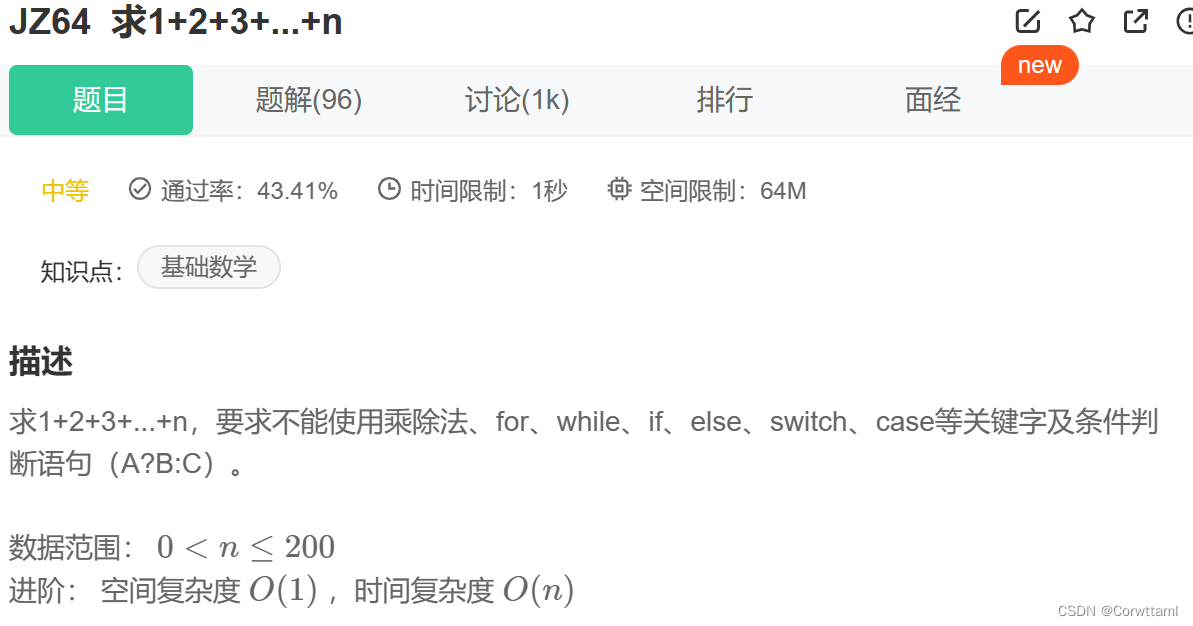
class CountN
{
public:
CountN()
{
_sum += _i;
_i++;
}
static int GetSum()
{
return _sum;
}
private:
static int _sum;
static int _i;
};
int CountN::_i = 1;
int CountN::_sum = 0;
class Solution {
public:
int Sum_Solution(int n) {
CountN* ptr = new CountN[n];
return CountN::GetSum();
}
};
#include <iostream>
using namespace std;
int main()
{
int year = 0, x = 0;
cin >> year >> x;
int monthArray[13] = { 0, 31, 28, 31, 30, 31, 30, 31, 31, 30, 31, 30, 31 };
if (year % 4 == 0 && year % 100 != 0 || year % 400 == 0)
{
monthArray[2] = 29;
}
int month = 0, day = 0;
for (int i = 1; i < 12; i++)
{
x -= monthArray[i];
if (x < monthArray[i + 1])
{
month = i + 1;
day = x;
break;
}
}
//注意输出格式
printf("%04d-%02d-%02d\n", year, month, day);
return 0;
}








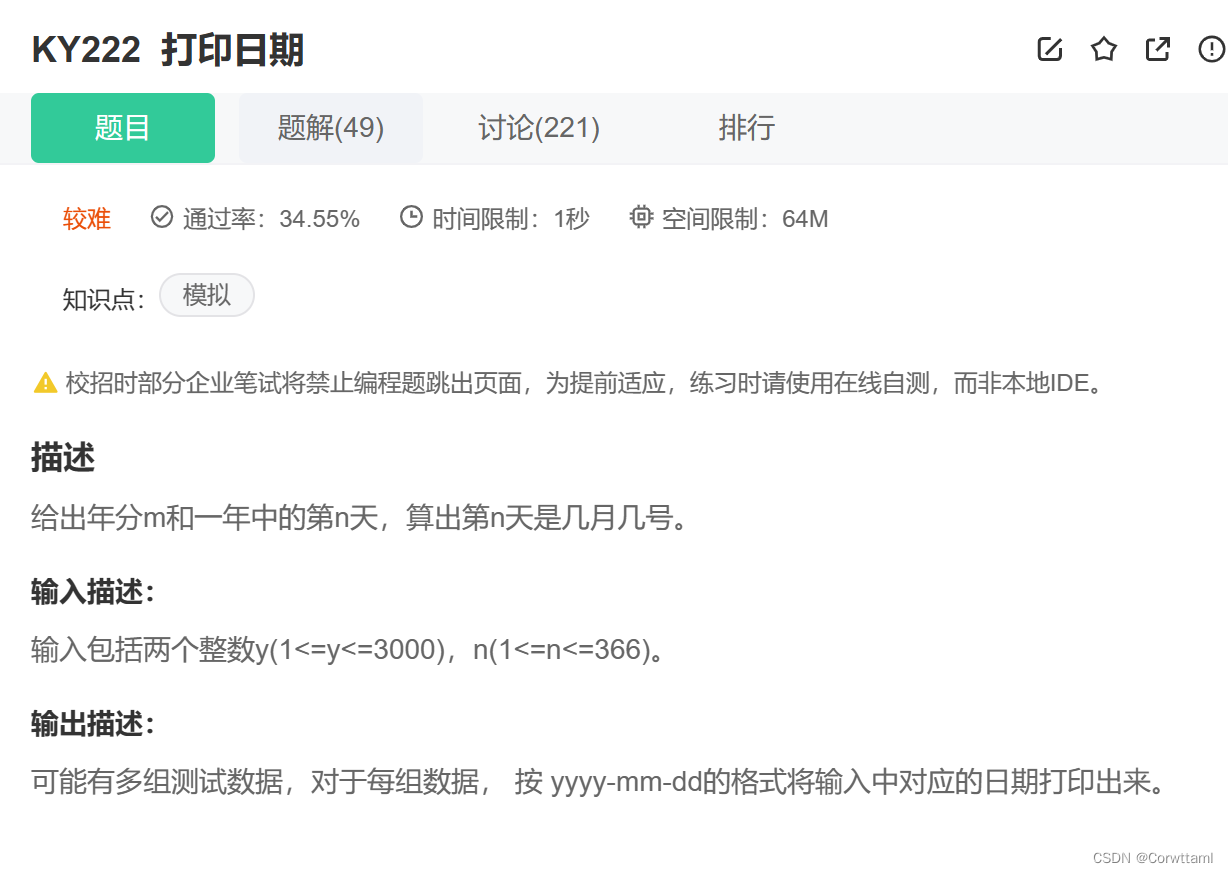















 3880
3880











 被折叠的 条评论
为什么被折叠?
被折叠的 条评论
为什么被折叠?










